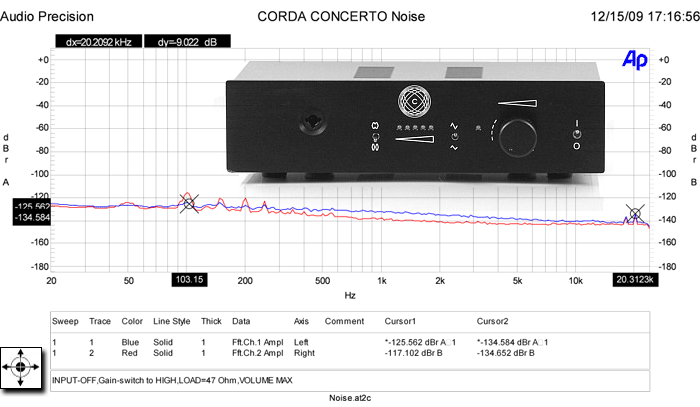This review page is supported in part by the sponsors whose ad banners are displayed below |
 |
 |
This sounded very similar to Wyred4Sound's solution in their award-winning STP-SE preamplifier. Jan took a look at their published materials and agreed. Unlike his Symphony's LM6171 opamp output device, the Concerto runs the socketed AD797. For stout power supply filtering, there's a butch 85.000uF of filter capacitance to optimize the opamps' performance. That's more than some power amplifiers. Front panel controls are simple - crossfeed engaged or bypassed; hi/lo gain; attenuator; and power on/off. A line of five red LEDs below the centrally placed logo shows signal strength (more LEDs for higher output) and gain (high gain illuminates the first LED, low gain skips it). The single LED to the left of the volume knob only light up with every second step to seem somewhat gratuitous. The rear panel with one line-level RCA input and power IEC is simpler still. The face plate and volume knob can be had in clear-anodized silver or black.
|
|
|
|
 |
As the supplied graph shows, the Concerto's noise floor measures stupendously low to indicate superior circuit design. For attractive end-user pricing, the German Jan Meier once again contracts with Shanling of China to manufacture just as he already did for the StageDAC. |

|
|
|
Jan Meier on the Concerto:
"My older models like the Cantate and Opera had a slightly warmer and slightly less detailed sound than the current Concerto and Symphony models. The main reason for this is in the volume control. While designing, testing and prototyping the Symphony, I found that the use of the classic Alps Blue potentiometer did add its own specific sound signature. Using a chain of discrete resistors and switching relays in the Symphony clearly improved detail and neutrality. The volume control relays on the Symphony are triggered by a rotary encoder.
The Concerto instead runs a DAC which measures the position of the analog potentiometer which triggers the relays. This not only gives a more analog feeling to the volume control but also allows for more discrete steps in smaller increments.
"Instead of the Symphony's LM6171 op-amp, the Concerto uses the AD797.
The LM6171 and AD797 sound a little different but these differences are surprisingly small. Both use bipolar inputs and I’ve always felt that FET opamps sound relatively veiled by comparison. More than any other opamp I've used before, the AD797 is very sensitive to power supply quality, hence I run 85.000uF of capacity via Nichicon audio-grade capacitors as well as extensive regulation and filtering.
I always use linear power supplies to prevent high-frequency noise pollution. The crossfeed circuit is very similar to the HeadFive but quite different from the StageDAC. The latter's implementation is far more complicated than those on all other Corda amplifiers to have better positional imaging. And yes, Grace uses my crossfeed cirucit but in
the original version without today's psychoacoustic bass compensation. All current Corda amplifiers with crossfeed have this newer compensation. The Concerto is available in black with blue LEDs or silver with red."
_______________________
* Looking at the part's spec sheet, we find 50mA of drive current, power supply rails of either ±5V or ±15V, a high slew rate of 20V/µs and good DC behavior with 80µV max input offset voltage.
|
 |
  |
 |
|